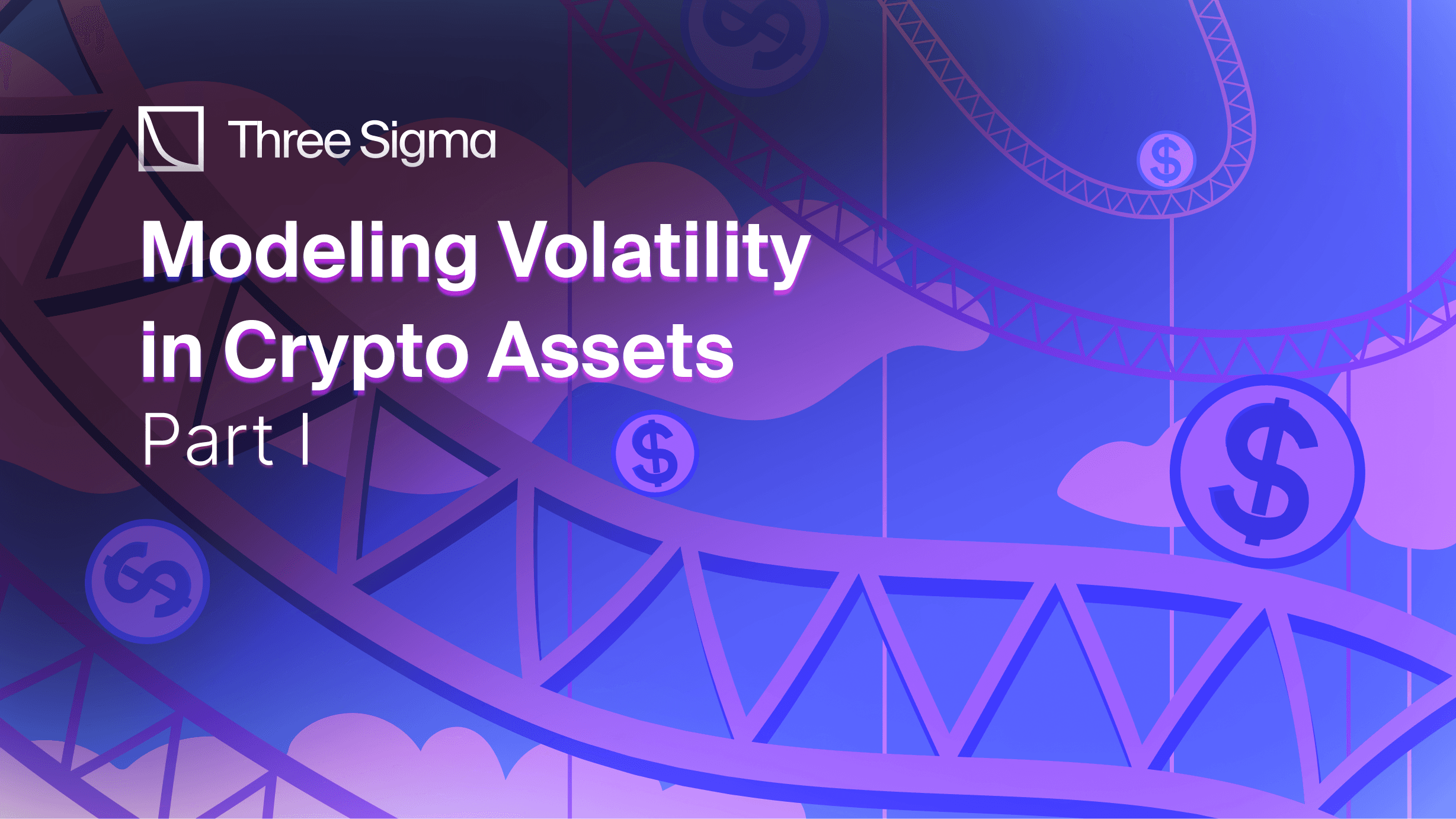Introduction
In the first part of our article, we explored the nature of volatility and its importance in the context of cryptocurrency markets. We also emphasized the usefulness of GARCH models for estimating volatility in financial markets. In this second part, we examine the applicability of these models to the cryptocurrency market. Our aim is to conduct a comprehensive analysis of the market's volatility dynamics using advanced modeling techniques that consider a range of specifications, parameters, and lags. Through the estimation of multiple models, we provide an in-depth examination of our results. This article ultimately seeks to advance the understanding of cryptocurrency volatility and provide valuable recommendations and avenues for future research, benefiting investors and researchers.
Methodology
Data
In this study, we utilized daily prices of nine different crypto assets over the entire time span available. The asset selection included Bitcoin, Ethereum, Uniswap, Lido, Curve, Compound, Euler, Aave, and GMX. In order to test whether perceived asset volatility might affect model choice, we included both less volatile and more volatile assets in our selection of assets.
It is useful to take into account the price returns while analyzing price trajectories. They can be calculated either as the percent difference between the price in t and t-1 or as the difference in logs. In comparison to percent difference, using log returns has a variety of advantages, with the symmetry of logarithmic returns being one of the most important ones. Unlike conventional returns, which are asymmetric, logarithmic returns with opposite signs cancel each other out at the same magnitude. This attribute is especially valuable in financial modeling since it ensures that the projected return on an asset over a certain period is unaffected by the direction of price movements. A further advantage of log returns is that they might facilitate more accurate modeling and simplify calculations. The original price, which may change over time, serves as the denominator for percent returns. As a result, it becomes more difficult to compare returns over time. Comparing returns over various time periods is made easier by the normalization of price data with log returns.
The log returns were computed using the following formula , where is the asset’s price at time .
Modeling
We first chose a normal distribution for the error term in the studied GARCH models, as this is a common practice in the financial industry. However, we also tested for a skewed Student's t-distribution, which is known to better capture fat tails and skewness. The skewed Student's t-distribution is characterized by an additional parameter, the skewness parameter, which indicates the direction and degree of skewness in the distribution. By testing both normal and skewed Student's t-distributions, we can compare the fit of each distribution and determine which one provides a better representation of the data. This approach allows us to assess the sensitivity of our results to the distributional assumptions made in the modeling process.
We used both EGARCH and GARCH models to estimate volatility because GARCH models assume positive and negative news have a symmetric impact on volatility. However, in reality, it has been observed that the stock market impact is usually asymmetric, and negative news tend to affect the volatility more than positive news. However, as we acknowledge in the first part of this article, it is not clear whether this asymmetric response is observable in the cryptocurrency market. Therefore, we compared the results from both models to assess whether the inclusion of asymmetry improves the fit to the data in this particular context.
In this study, we tested three different mean model specifications within the GARCH framework: constant, zero, and autoregressive. A constant mean model implies that the time series has a fixed average level that does not vary over time. This could be appropriate if the series is expected to exhibit this stable, predictable behavior over time. A zero mean model assumes that the time series is centered around zero and is suitable if there is no inherent trend or level in the data. An autoregressive mean model incorporates the past values of the time series to model its mean and can capture the persistence and dynamics of the series. Selmi and Mensi (2017) used a zero mean GARCH model to analyze Bitcoin returns, as they believed there was no inherent trend or level in the data. This approach allowed the authors to focus on modeling the volatility of the returns, rather than the mean. Additionally, the use of a zero mean GARCH model is consistent with the efficient market hypothesis, which suggests that asset prices follow a random walk with no predictable trends or patterns, and that any deviations from a zero mean would be due to temporary shocks or noise in the market. However, it is important to note that the efficient market hypothesis has been subject to criticism, and some studies suggest that there may be some predictability in asset prices, including in cryptocurrency markets. Therefore, while a zero mean model may be appropriate in some cases, an autoregressive mean model may be more suitable in others. For example, Liew and Baharumshah (2018) found that an ARMA-GARCH model provided a better fit for Bitcoin returns compared to a GARCH model with a constant or zero mean.
We reached our estimations using a combination of several mean specifications, distributions, and models, as well as many lags of historical returns, in order to present a full study of the volatility dynamics in the cryptocurrency market.
We used the maximum likelihood estimation (MLE) approach, a statistical method for estimating the parameters of a probability distribution by maximizing the likelihood function, to estimate the parameters of the volatility models. The maximum likelihood estimator determines the parameter values that, given the assumed distributional assumption, make the observed log returns the most likely.
Model selection
To rank the models and ultimately determine which performed better for each selected asset, we used the Akaike information criterion (AIC) and the Bayesian information criterion (BIC). AIC and BIC measure model performance while taking into account model complexity by combining a term that reflects how well the model fits the data with a term that penalizes the model in proportion to its number of parameters. AIC and BIC are easier to compute than a cross-validation estimate of predictive performance and can accurately select the best model when their assumptions are met. The best model is the one with the smallest AIC or BIC value, which indicates the least information loss relative to the true model. The difference between BIC and AIC is the greater penalty imposed for the number of parameters by the former.
We used a significance level of 5% throughout our analysis to identify statistically significant coefficients in our models. This approach is based on the null hypothesis that no relationship can be found between the independent and dependent variables. Rejecting the null hypothesis and concluding a significant relationship between variables occurs when the p-value is less than 0.05.
Findings
General results
By analyzing a large dataset of daily returns for nine different crypto assets, the study was able to identify the best models for each asset based on the AIC and BIC criteria.
The table below provides a summary of the best model chosen based on both metrics. Throughout the discussion of the results, the different combinations of lags, mean model and residual distribution are noted in the form of (p, q, mean model, distribution).

The initial results show that different assets exhibit unique patterns of volatility and that these patterns are best captured by specific models. For example, considering the AIC, the study found the EGarch(10, 10, zero, skewt) model to be the best fit for Bitcoin, while the EGarch(1, 1, constant, skewt) model was the top choice for Ethereum. These models take into account the asymmetric and fat-tailed nature of cryptocurrency returns, which is often not captured by traditional models like the GARCH with a normal distribution. The study also found that the Uniswap and GMX assets showed a preference for the EGarch(1, 1, zero, skewt) model, which suggests that these assets have similar volatility dynamics. In contrast, the Garch(1, 1, zero, skewt) model was found to be the best fit for Compound and Euler, indicating that these assets have a different volatility pattern than the other assets. Similarly, the EGarch(2, 2, zero, skewt) model was found to be the top choice for Lido, which again suggests a unique volatility pattern.
These demonstrate that the skewed Student's t-distribution consistently outperforms the normal distribution in modeling cryptocurrency returns. This is clearly reflected in the table, which shows that all of the best models identified based on AIC and BIC criteria incorporate this distribution rather than the normal distribution. This finding is not surprising, given the well-known presence of fat tails and skewness in crypto assets, explored in the first part of this article. Moreover, it is important to note that this result is not limited to the best models only; it is evident across all the models that were regressed.
Our analysis revealed that the mean zero model, according to both BIC and AIC, consistently outperformed the other mean models considered, which is consistent with the findings of Selmi and Mensi (2017). This finding indicates that cryptocurrency markets may not exhibit an inherent trend or level in the data, making modeling the volatility of the returns more informative than modeling the mean. Moreover, the lack of statistical significance of the mean coefficient suggests that including a mean model may not be necessary in most of cases. However, for Ethereum, the mean constant model was the best performing model according to AIC, with the mean coefficient being statistically different from zero.
Our findings also revealed that coefficients of models with larger lags were most of the time not statistically different from zero. As a result, models with lags equal to one consistently outperformed the other models, especially when considering the BIC, which penalizes model complexity more strongly. This indicates that volatility is largely influenced by volatility from the previous day and not from days earlier. However, given that the majority of coefficients for higher lags were not statistically different from zero, we could not draw any conclusions about the different types of assets and model selection.
For most of the models analyzed, the gamma coefficient was not statistically different from zero, indicating that there was no significant asymmetry effect. Please refer to part 1 of this article to recall the definitions of the various coefficients used in GARCH estimation. For example, for Bitcoin, this coefficient was statistically different from zero in 3 out of the 15 models analyzed. These models were EGarch(10, 10, zero, skewt), EGarch(3, 3, constant, skewt), and EGarch(3, 3, AR, skewt). For Ethereum, none of the gamma coefficients were statistically different from zero. This finding aligns with the initial understanding that the asymmetry effect may be less widespread in the cryptocurrency market due to the presence of more enthusiastic and less sophisticated traders who take a price increase as a positive trend. These characteristics of the cryptocurrency market should be considered in the accurate analysis and forecasting of its financial time series. However, it should be emphasized that this can be a sign of a recent industry and might not hold true indefinitely. Interestingly, for the cases in which the gamma coefficient was statistically different from zero, the EGarch models still outperformed the Garch models.
Overall, our research provides light on the importance of coefficients being statistically significant from zero in the best-performing models for cryptocurrency. We found that removing these coefficients on numerous occasions led to improvements in both BIC and AIC.
The results indicate that the statistical properties of cryptocurrency returns may be influenced by unique market characteristics. The non statistically significance of mean model coefficients, gamma coefficient, and larger lags suggest that the behavior of some assets may not depend heavily on the past and exhibit less pronounced asymmetry effects, possibly due to limited data availability or the tendency of most assets to mimic Bitcoin.
Indeed we observe many similarities, when comparing the logarithmic returns of different crypto assets. The graphs below display the logarithmic returns of Bitcoin, Ethereum, and Uniswap for the same time period, indicating a similar behavior of returns over time, albeit with varying magnitudes. Bitcoin, being a more stable crypto asset, as expected, has less pronounced volatility magnitude. Nonetheless, returns appear to react similarly across time, with peaks observed around the same month and year across all models. For example, all series show a large spike around May 2021. It is important to recognize the differences between the crypto industry and traditional finance to determine the appropriate models to use for volatility analysis. This is due to the fact that models that perform well in the stock market may not be applicable in the crypto market, where assets are highly correlated. This correlation can impact the development and application of volatility models, requiring a closer look at case-specific details to choose the most applicable model.



Therefore, correctly identifying the non-zero coefficients in EGarch/Garch models seems to be essential to capture these unique features, emphasizing the importance of considering the distinct nature of cryptocurrency data when building models for analysis and prediction. These findings highlight the need for further exploration of the underlying drivers of cryptocurrency returns and the market itself.
Results when excluding the initial observations
We decided to exclude the first 30 days of trading data, based on our understanding of how disproportionately volatile the cryptocurrency market can be in the early stages of a new token or coin. Extreme price volatility may distort the overall picture, making it more difficult to draw significant conclusions. By excluding this period from our analysis, we aim to reduce noise and give a more accurate and trustworthy model of the cryptocurrency's volatility.
Indeed, as seen in the Ethereum log return chart (below), the largest peak occurs within the first few days of the period.

However, the skewed t-distribution continues to outperform the normal distribution in all cases. This finding is consistent with our previous analysis that included the entire dataset. Even when removing the highly volatile initial period of trading, we observed that the Skew t-distribution provides a better fit for modeling cryptocurrency returns. This suggests that the cryptocurrency market exhibits a higher degree of skewness and kurtosis than a normal distribution can adequately capture.
With the exception of GMX, the best model remains the same for both cases. This result indicates that the choice to exclude the initial 30 days of trading data does not significantly impact the selection of the best-fitting model for most cryptocurrencies. However, it is important to note that this consistency in model selection provides confidence in the reliability of the models we have selected. When models match across datasets, it suggests that the models are robust and provide a consistent understanding of the underlying phenomena.
GARCH models can enhance DeFi risk logic or mislead it if misapplied. Our DeFi Ecosystem Strategic RD service helps teams apply volatility models safely across lending, options, insurance, and dynamic pricing systems.
Conclusion
In conclusion, our study highlights the importance of GARCH/E-GARCH models in providing accurate estimates of market volatility in cryptoassets, which is crucial given the large applicability and significance of this metric in the crypto market. The statistically significant non-zero coefficients in the best-performing models are essential in capturing the unique features of this data, emphasizing the importance of considering the distinct nature of assets when building models for analysis and prediction.
Moreover, we concluded that further analysis of short- versus long-term volatility patterns, as well as adopting higher frequency data to capture intraday dynamics, could improve the precision and applicability of these models. By analyzing short-term and long-term volatility, we can account for sudden changes in market sentiment or underlying economic fundamentals, thereby enhancing the accuracy of GARCH models for crypto assets, in particular for forecasting. Furthermore, ensuring a balance between the frequency of data used and the computational demands of the model is crucial, as both too high and too low frequency may negatively impact the accuracy of the model. Nevertheless, considering that crypto assets can be traded continuously while the stock market has opening and closing times, it seems reasonable to test models with different data frequencies.
Another exploration avenue that surfaced is tied to the purpose of measuring volatility. For instance, we are probably only concerned about shorter term volatility if we are analyzing an asset's volatility to determine the risk associated with using it as collateral. On the other hand, we can be concerned with long-term volatility when creating a portfolio. One of our propositions for next steps is to determine whether different models should be utilized for different applications. Recently, some researchers have introduced hybrid methods by combining machine learning methods, such as Artificial Neural Networks (ANN) and Support Vector Regression (SVR), with GARCH-type models to improve the volatility forecasts. As these types of models are known to thrive on abundant data, we are looking forward to analyzing how they perform with higher frequency data in the context of cryptocurrencies, particularly for short term forecasting.
Sources & References
- Alexander, C., & Gholampour, V. (2018). Bitcoin: Medium of exchange or speculative assets? Journal of Financial Economics, 130(2), 367-378. https://doi.org/10.1016/j.jfineco.2018.05.005
- Box, G. E. P., & Jenkins, G. M. (1970). Time series analysis: Forecasting and control. Holden-Day.
- Chan, J. C. C., & Eisenstat, E. (2020). Time-varying price discovery in cryptocurrency markets. Journal of Empirical Finance, 56, 42-58.
- Gonçalves, S., & Meddahi, N. (2018). Multivariate GARCH models: A survey. Journal of Applied Econometrics, 33(1), 1-23. https://doi.org/10.1002/jae.2574
- Hansen, P. R., & Lunde, A. (2005). A forecast comparison of volatility models: Does anything beat a GARCH(1,1)? Journal of Applied Econometrics, 20(7), 873-889. https://doi.org/10.1002/jae.837
- Liew, V. K. S., & Baharumshah, A. Z. (2018). On the returns of Bitcoin investment. Economics Letters, 166, 23-27.
- O'Connor, M. (2019). The efficiency of the Bitcoin market: An analysis of Bitcoin market efficiency and volatility using Google search data. Journal of Risk and Financial Management, 12(3), 114. https://doi.org/10.3390/jrfm12030114
- Selmi, R., & Mensi, W. (2017). The impacts of terrorism on stock market volatility: Evidence from eight OECD countries. Finance Research Letters, 21, 36-42.
- Tsyvinski, A., & Liu, Y. (2018). Cryptocurrencies as an asset class: An empirical assessment. National Bureau of Economic Research. https://doi.org/10.3386/w24877

Economic Modeler
Carolina is a data analyst with a Master’s degree in analysis and engineering of big data and a background in mathematics applied to economics and management. She has experience working on optimization problems, leveraging statistics to produce simulations and extract valuable insights. She joined Three Sigma with a continued passion for finding knowledge in data and an interest in improving the blockchain industry by contributing to its sustainable development. Outside of work, Carolina enjoys traveling and immersing herself in foreign environments.

Economic Modeler
Joana has a Master’s degree in finance and a background in mathematics applied to economics and management. She has spent the past three years working at a private equity company, becoming familiar with traditional finance concepts and honing her analytical skills. The opportunity to blend her mathematical expertise with her finance background is what initially sparked her interest in the blockchain field. Joana joined Three Sigma with a strong eagerness to make a valuable contribution to the world of decentralized finance, which she excitedly believes has great potential. In her free time, Joana enjoys traveling and engaging in sports.






